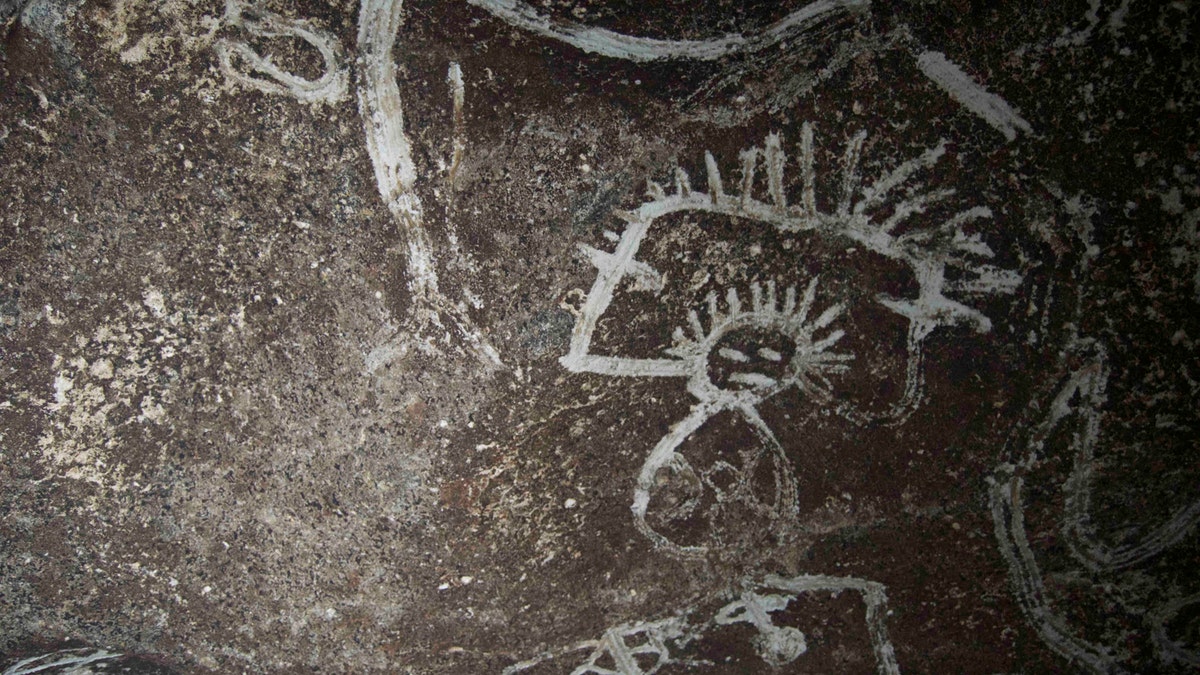
Indigenous rock art from Mona island. Note how the artist uses the contrast between the darker cave wall and the white design (Project El Corazon del Caribe)
Experts have uncovered a vast array of mysterious pre-Columbian rock art in the caves of a remote uninhabited Caribbean island.
Archaeologists explored around 70 cave systems on Puerto Rico’s Mona island. The thousands of designs, created centuries ago, comprise the largest concentration of indigenous pre-Columbian rock art in the Caribbean, according to experts.
A paper, published in the Journal of Archaeological Science, describes the incredible art in the labyrinthine cave network, spanning human, animal and “meandering” designs. While some of the designs are painted or drawn, others have been scratched with fingers into the soft walls of the cave, a similar technique to that used in the Palaeolithic rock art of Southern Europe.
16TH-CENTURY CHRISTIAN SYMBOLS FOUND IN CARIBBEAN CAVE
“Most of the work we have identified in this scientific study is done during an intense period of indigenous activity in the caves between AD1200 and European arrival after AD1492,” explained Dr. Jago Cooper, curator of the Americas at the British Museum, who worked on the paper.

Freshwater lake inside a cave on Mona island (Project El Corazon del Caribe)
In an email to Fox News, Cooper explained that the indigenous population in the Caribbean likely numbered in the millions when Europeans arrived. “On Mona they might be described as Taino, a name given to the indigenous population living in Puerto Rico and Hispaniola at this time,” he added.
In addition to the British Museum, the University of Leicester in the U.K., the British Geological Survey and Cambridge University all worked on the cave project. Students from the U.K. and Puerto Rico carrying out dissertations in climate science, archaeology and history also participated.
EXPERTS DISCOVER 'CHRISTOPHER COLUMBUS' ANCHOR AT CARIBBEAN SHIPWRECK SITE
The rock art offers a fascinating glimpse into Mona’s forgotten Taino population. As a result of European raids, most of the indigenous population on Mona is thought to have died or fled the island by the end of the 16th century.

Indigenous rock art from Mona island. "Finger-fluted" design scratched by the artist into the soft walls of the cave (Project El Corazon del Caribe).
“Scientific analyses from the team have provided the first dates for rock art in the Caribbean - illustrating that these images are pre-Columbian made by artists exploring and experimenting deep underground,” said Dr. Alice Samson, lecturer in archaeology at the University of Leicester, who co-authored of the paper, in a statement.
500-YEAR-OLD NATIVE AMERICAN CANOE TO BE UNVEILED TO THE PUBLIC AT MISSISSIPPI MUSEUM
Cooper told Fox News that the Taino people snorted a drug called Cohoba, which is the ground seeds of the cojobana tree, as part of their religious rites. While the drug was not necessarily used by the cave artists, it was likely used by their leaders, according to Cooper.
“Cohoba was a powerful hallucinogenic drug taken by Taino caciques (chiefs) or spiritual leaders to help facilitate engagement with the spiritual world,” he said. “We also know that caves are spiritual domains as the Taino have an origin myth that their people emerged from a cave called Cacibajagua.”
The paper published in the Journal of Archaeological Science is the result of research undertaken between 2013 and 2016. The Mona fieldwork was funded by National Geographic.
NATIVE AMERICAN CANOE FROM 1700s PRESERVED AT MAINE MUSEUM
Last year archaeologists announced the discovery of 16th-century Christian symbols alongside ancient indigenous rock art in a cave on the island of Mona.
Follow James Rogers on Twitter @jamesjrogers




















